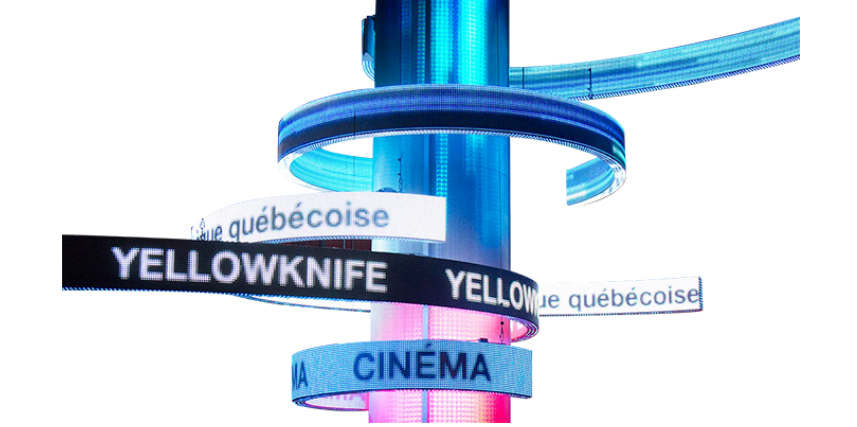Comment personnaliser un écran d’affichage LED cylindrique ?
Customizing a cylindrical LED display screen involves designing, manufacturing, and implementing a unique curved LED screen to meet specific requirements and create an immersive visual experience. Cylindrical LED displays are gaining popularity in various applications, including retail, advertising, events, exhibitions, and architectural installations, due to their eye-catching and unconventional shape. In this article, we'll explore the steps and considerations involved in customizing a écran d’affichage à LED cylindrique.
- Display Size and Shape: Specify the dimensions of the cylindrical screen, including its diameter, height, and curvature. Decide on the desired aspect ratio and the degree of curvature needed to achieve the desired visual effect.
- Resolution and Pixel Pitch: Determine the resolution requirements based on the content to be displayed and the viewing distance. The pixel pitch (the distance between individual LED pixels) is crucial in maintaining image clarity and sharpness.
- Viewing Angle: Assess the viewing angles required for the cylindrical LED display. Depending on the installation location and audience, wide viewing angles may be necessary to ensure visibility from various vantage points.
- Content and Application: Understand the type of content that will be displayed and the intended application. Different content types (videos, images, text) may have varying requirements in terms of resolution, color accuracy, and refresh rates.
- Environment and Durability: Consider the installation environment, as this can affect the LED screen's protection against dust, water, and other environmental factors. For outdoor installations, the screen may need to be weatherproof and have adequate brightness to combat ambient lighting conditions.
- 3D Modeling: Use computer-aided design (CAD) software to create a 3D model of the cylindrical LED display, allowing visualization of the final product and identification of potential design challenges.
- Mechanical Structure: Design the mechanical structure of the cylindrical display, taking into account the frame, support system, and any other components required to ensure stability and proper assembly.
- Curvature and Alignment: Precisely define the curvature of the cylindrical screen to achieve the desired viewing experience. Accurate alignment of Panneaux LED is essential to maintain seamless content continuity across the curved surface.
- Cooling and Ventilation: Address the thermal management of the LED display to prevent overheating and ensure optimal performance and longevity. Proper ventilation and cooling mechanisms should be integrated into the design.
- Surface-Mounted Device (SMD) LEDs: SMD LEDs offer better image quality and wider viewing angles compared to traditional discrete LEDs. They are commonly used in modern LED displays and are suitable for cylindrical screens.
- Flexible LED Modules: To accommodate the curved shape of the display, flexible LED modules are often used. These modules can be bent to fit the cylindrical surface without compromising image quality.
- Transparent LEDs: For certain applications, such as architectural installations, transparent LED modules might be preferred. They allow light and visuals to pass through the display, offering unique visual effects.
- LED Module Assembly: The LED modules, comprising SMD LEDs on flexible PCBs, are assembled to form panels or strips, depending on the display's design.
- Quality Control: Rigorous quality control measures should be in place throughout the manufacturing process to ensure that each LED module meets the required specifications for brightness, color uniformity, and functionality.
- Panel Alignment: During assembly, precise alignment of the LED panels or strips is crucial to maintain a seamless and uniform display surface.
- Content Creation: Design or adapt content to fit the cylindrical display's unique shape and resolution. Consider how visuals will wrap around the curved surface and appear from different viewing angles.
- Control System Integration: The Affichage LED should be integrated with a user-friendly control system that allows operators to manage and schedule content efficiently. This system should offer remote control and monitoring capabilities for ease of use.
- Mounting and Rigging: Securely mount the LED panels on the cylindrical frame or structure, ensuring stability and safety. Rigging may be required for suspended installations.
- Image Calibration: Use specialized software and calibration tools to adjust brightness, color, and uniformity across the display surface. This step ensures a consistent and high-quality visual experience.
- Regular Inspections: Periodic inspections are essential to identify and address any technical issues promptly. This can involve checking for dead pixels, loose connections, and other potential problems.
- Software Updates: Keep the content management and control software up to date to access the latest features and improvements.
- Technical Support: Establish a support channel with the LED display manufacturer or vendor to address any technical queries or issues that may arise.
If you want to know more information about LED display screen, S’il vous plaît contactez-nous. We will provide professional answers.
1. Définir les exigences :
The first step in customizing a cylindrical LED display is to clearly define the project requirements. This includes determining the following aspects:- Display Size and Shape: Specify the dimensions of the cylindrical screen, including its diameter, height, and curvature. Decide on the desired aspect ratio and the degree of curvature needed to achieve the desired visual effect.
- Resolution and Pixel Pitch: Determine the resolution requirements based on the content to be displayed and the viewing distance. The pixel pitch (the distance between individual LED pixels) is crucial in maintaining image clarity and sharpness.
- Viewing Angle: Assess the viewing angles required for the cylindrical LED display. Depending on the installation location and audience, wide viewing angles may be necessary to ensure visibility from various vantage points.
- Content and Application: Understand the type of content that will be displayed and the intended application. Different content types (videos, images, text) may have varying requirements in terms of resolution, color accuracy, and refresh rates.
- Environment and Durability: Consider the installation environment, as this can affect the LED screen's protection against dust, water, and other environmental factors. For outdoor installations, the screen may need to be weatherproof and have adequate brightness to combat ambient lighting conditions.
2. Conception et ingénierie :
Once the requirements are clear, the design and engineering phase begins. This involves collaborating with LED display manufacturers or engineering teams that specialize in creating customized LED displays. Key aspects of this phase include:- 3D Modeling: Use computer-aided design (CAD) software to create a 3D model of the cylindrical LED display, allowing visualization of the final product and identification of potential design challenges.
- Mechanical Structure: Design the mechanical structure of the cylindrical display, taking into account the frame, support system, and any other components required to ensure stability and proper assembly.
- Curvature and Alignment: Precisely define the curvature of the cylindrical screen to achieve the desired viewing experience. Accurate alignment of Panneaux LED is essential to maintain seamless content continuity across the curved surface.
- Cooling and Ventilation: Address the thermal management of the LED display to prevent overheating and ensure optimal performance and longevity. Proper ventilation and cooling mechanisms should be integrated into the design.
3. Choisir la bonne technologie LED :
Choosing the appropriate LED technology is a critical aspect of customizing a cylindrical LED display. Different LED types include:- Surface-Mounted Device (SMD) LEDs: SMD LEDs offer better image quality and wider viewing angles compared to traditional discrete LEDs. They are commonly used in modern LED displays and are suitable for cylindrical screens.
- Flexible LED Modules: To accommodate the curved shape of the display, flexible LED modules are often used. These modules can be bent to fit the cylindrical surface without compromising image quality.
- Transparent LEDs: For certain applications, such as architectural installations, transparent LED modules might be preferred. They allow light and visuals to pass through the display, offering unique visual effects.
4. Fabrication et assemblage :
The manufacturing process involves producing the individual LED modules, panels, or strips that will form the cylindrical display. This process includes:- LED Module Assembly: The LED modules, comprising SMD LEDs on flexible PCBs, are assembled to form panels or strips, depending on the display's design.
- Quality Control: Rigorous quality control measures should be in place throughout the manufacturing process to ensure that each LED module meets the required specifications for brightness, color uniformity, and functionality.
- Panel Alignment: During assembly, precise alignment of the LED panels or strips is crucial to maintain a seamless and uniform display surface.
5. Système de gestion et de contrôle du contenu :
To operate the cylindrical LED display effectively, a robust content management system and control software are necessary. This system enables content creation, scheduling, and real-time updates, ensuring dynamic and engaging visual content:- Content Creation: Design or adapt content to fit the cylindrical display's unique shape and resolution. Consider how visuals will wrap around the curved surface and appear from different viewing angles.
- Control System Integration: The Affichage LED should be integrated with a user-friendly control system that allows operators to manage and schedule content efficiently. This system should offer remote control and monitoring capabilities for ease of use.
6. Installation et étalonnage :
The installation process involves mounting the cylindrical LED display in the designated location. Calibration is a critical step to ensure that the LED panels are accurately aligned and calibrated to display content seamlessly across the curved surface:- Mounting and Rigging: Securely mount the LED panels on the cylindrical frame or structure, ensuring stability and safety. Rigging may be required for suspended installations.
- Image Calibration: Use specialized software and calibration tools to adjust brightness, color, and uniformity across the display surface. This step ensures a consistent and high-quality visual experience.
7. Maintenance et support :
After the cylindrical LED display is installed and operational, ongoing maintenance and support are necessary to ensure its longevity and optimal performance:- Regular Inspections: Periodic inspections are essential to identify and address any technical issues promptly. This can involve checking for dead pixels, loose connections, and other potential problems.
- Software Updates: Keep the content management and control software up to date to access the latest features and improvements.
- Technical Support: Establish a support channel with the LED display manufacturer or vendor to address any technical queries or issues that may arise.
Conclusion
Customizing a affichage LED cylindrique screen involves a multidisciplinary approach, combining design, engineering, LED technology selection, manufacturing, content management, and installation. Proper planning and collaboration with experienced LED display specialists are crucial to achieving a visually stunning and functional cylindrical LED display that meets the specific requirements of the intended application. With careful attention to detail and precise execution, a customized cylindrical LED display can leave a lasting impression on audiences and create immersive visual experiences.If you want to know more information about LED display screen, S’il vous plaît contactez-nous. We will provide professional answers.







Laisser un commentaire